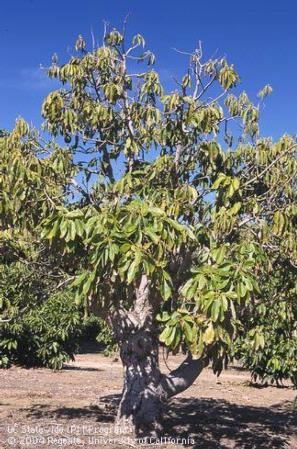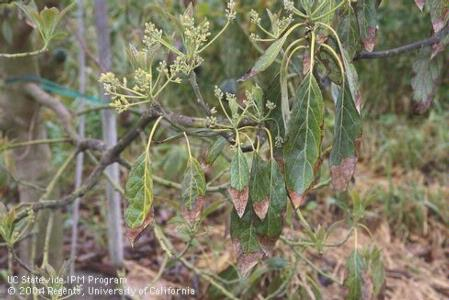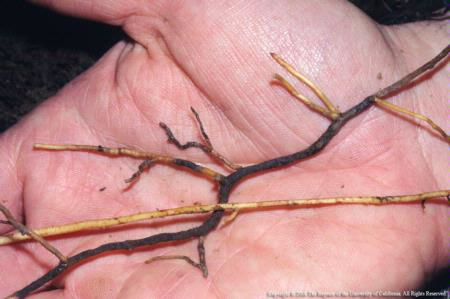
Posts Tagged: canopy
Avocado Illusion
Old crop, new crop. What's up there in the trees? Are they big enough to sell? Is there a good set for next year? These are questions every avocado grower has every year, and often all year long. What is up there in the trees is confounded by what is called the "Avocado Illusion".
In a Science Magazine Letters to the Editor in Dec 1990, Paul Sandorff commented on a book written by Maurice Hershenson called The Moon Illusion. In the book Hershenson described the illusion of why the moon seemed so much larger when it was on the horizon than when it rose to its zenith on the same night. http://science.sciencemag.org/content/250/4988/1646.1

Sandorff said that this illusion applied to avocados since it was so hard to gauge the size of avocados when they were in the tops of the tree canopy. It is the surrounding environment that puts a context to size according to this theory of illusion.
Hershenson added to this observation in the March 1991 Science letters section with the comment that the leaves surrounding the fruit changes our depth perception and so changes our idea of the fruit size.
A further addendum to the avocado illusion theory is that since the fruit are the same color as the leaves (they are both dark green and the fruit unlike most other fruit continues to photosynthesize), it is hard to actually make out the fruit. You can be looking right at the fruit and not see it, confusing it with a leaf.
This illusion makes for difficult fruit estimation. To compensate for this illusion, I will eye the canopy in quadrants, counting the number of fruit, then arbitrarily doubling that total number. It usually gives a pretty close number to the real number of fruit that are in the tree.
Photo:
Can you count the number of fruit in this canopy?

canopy fruit avocado
What to Expect of Young Trees or Teach your Children Well
The first years of a tree's life are for building a structure for the future. Many varieties of trees are precocious and will bear fruit when they should be building structure. Letting a tree carry fruit when it is too young (under 2 years of age in the ground and some say 5 depending on the tree species) delays future good production and distorts the tree's architecture. A young avocado tree can be completely humbled (brought to ground literally) by the weight of the 12 ounce fruit. ‘Lamb Hass' wants to grow upright, but if the young tree is burdened with fruit early on, it will grow squat and twisted.
Another problem with precocious trees recently came up with ‘Meyer' lemon. Along the coast, this is a tree that will carry fruit throughout the year. It is a small tree naturally, but also because it puts so much energy into fruit production. If allowed to fruit to its full potential early, the canopy development is delayed and the fruit grows unprotected from winds. It is much more subject to wind scarring. Imagine the wind flailing the fruit around with no branches or leaves to protect it. Now the grower has a small, twisted fruit tree and fruit that can't be sold.
Give your young trees a chance to grow without the burden of carrying fruit to early. They are your children.
Imagine all this fruit on a one year old canopy
And this fruit is fully exposed to the elements and wind scarring

Lamb Hass pulling on tree

meyer lemon wound
Citrus Canopy Management in a Drought
Transpiration is essentially a function of the amount of leaves present. With no leaves, there is no transpiration and no water use. The extreme case is tree removal. If canopies are pruned there is reduced water use. The more canopy reduction, the more transpiration reduction. Most citrus produces terminal flowers, so there is also a reduction in yield, but there is also typically an increase in fruit size as competitive fruit growing points are removed. There is a balance between yield reduction and tree water use, but typically a 25% canopy reduction results in a 25% decrease in tree water use (Romero, 2006).
The severity of the drought will determine how drastic the canopy should be trimmed. The trees can be skeletonized so that only the main structural branches are left. The tree is whitewashed to prevent sunburn and the water is turned off. As the tree gradually leafs out, the water is gradually reapplied in small amounts. It's important to check soil moisture to make sure the tree do not get too much or too little water. The trees if pruned in the winter will often flower a year later in the spring, but normal production will often take three years for the trees to recover their previous yields.
Skeletonizing should first be practiced on orchards that are the poorest producing. In those areas that get too much wind and have lots of wind scarring or elevated water use, those areas that are most prone to frost damage, those areas that have been always problematic, such as fruit theft. In areas that are healthy and a new variety has been contemplated, this is the time to topwork and replace that old variety. In areas that have been poor producing from disease, this is the time to get rid of those trees.
Canopy sprays of kaolinite clay have shown some promise in reducing transpiration with negligible yield reduction (Skewes, 2013; Wright, 2000). If these are used, they should be done under the advisement of the packing house to make sure the clay can be removed in the packing house.
With a reduced canopy, there are often other benefits besides water reduction. There is better spray coverage for pest control. There is also reduced fertilizer use. New growth is normally coming from nutrients that are now being mined by a large root system and fertilizer applications can be significantly reduced or eliminated altogether for a year until fruit set recommences.
Citations
Kerns, D. and G. Wright. 2000. Protective and Yield Enhancement qualities of yield of kaolin on lemon. In: Eds. G. Wright and D. Kilby, AZ1178: "2000 Citrus and Deciduous Fruit and Nut Research Report," College of Agriculture and Life Sciences, University of Arizona. http://extension.arizona.edu/sites/extension.arizona.edu/files/pubs/az1178_3.pdf
Skewes, M. 2013 Citrus Drought Survival and Recovery Trial. HAL Project Number CT08014 (16/12/2013). SARDI. http://pir.sa.gov.au/__data/assets/pdf_file/0004/238414/SARDI-Citrus-Drought-Survival-Recovery-Trial.pdf
Navel trees skelotinized and topworked, ready for rain and more profits in the future.

navels skeletonized and grafted
To skirt or not to skirt, that is the question
There is a running debate about whether avocado canopies should be skirted up, raised up so that you can see under the canopy. In doing so, the tree’s tendency is to maintain its bearing volume by increasing a similar amount in height that is lost by removing the bottom layer of canopy. A tree with a full canopy is more cold resistant because it traps heat inside the canopy and is not so prone to cold winds. In an inversion freeze, though, warming air from irrigation, wind machines and orchard heaters is less likely to circulate when the skirts block air movement. A low skirt also impedes a uniform application of water from microsprinklers, and hence fertilizer distribution. A low skirt also has more fruit lying on the ground which is more uneven in coloration and more prone to disease and possibly food safety issues. A raised skirt also promotes more air circulation within the canopy which can reduce the incidence of some other diseases of both fruit, stems and branches.
A raised skirt, though exposes the base to light, and if there is no leaf mulch, there are more weeds to control. In the case of hillsides, because of gravity and wind exposure, leaves tend to blow away. The roots are now more exposed to drying because of increased evaporative loss. Loss of leaves is also a major disease problem, since leaves and organic matter are the first lines of defense (after proper irrigation management) against Phytophthora root rot. It is the microorganisms breaking down the leaves that create a hostile environment for the Phytophthora pathogen. In fact, in releasing enzymes to break down organic matter, the microorganisms also break down the cell walls of Phytophthora which are made of the same material as leaves. An orchard with no leaves is wide open to root rot infection.
So I propose something modest. On flat ground where trees are more prone to frost damage, and less subject to winds blowing away leaves that the trees are skirted. On slopes, though where winds blow away leaves and the trees are less subject to low lying cold, that the skirts are left. To maintain a more even water distribution, though, windows are cut into the canopy on the side facing the microsprinkler so that the canopy does not interfere with water spray.

skirting
Signs of Avocado Root Rot
In the last two weeks I’ve been out to see groves that have root rot, yet the growers did not recognize the signs. Two years of drought and use of salt loaded water have put stress on trees and made them more susceptible to root rot. Although irrigation management can bring about the symptoms of root rot – small, yellow, tip-burned leaves – because the tree in both cases is seeing a lack of water. I thought it would be appropriate to review the symptoms of avocado root rot.
What to look for:
Small, yellow, tip-burned leaves
Thin canopy
Die-back in the canopy, causing stag-horning (dead stems)
Little or no new leaf growth, hardened look to the leaves
Few or no leaves on the ground (tree doesn’t have energy to produce leaves)
Profuse flowering and small fruit
Sunburned fruit from reduced canopy
Then get on your knees and dig around in the wetted area of the root zone
Do you find roots in the top 3 inches of soil? NO, that’s a bad sign
Do you find any white root tips (it’s hard to find these when the soil is cold in the winter)? NO, that’s a bad sign.
Do you find black roots? Yes, that’s a bad sign.
These are all field diagnostics for avocado root rot. You can also sample roots and send them in for lab analysis, but in the winter, the root rot organisms are not active and you can actually get a false negative. Meaning the lab won’t pick it up and you then think you don’t have the disease. Use field clues to figure out whether you have root rot. Then figure out why you have it. It usually boils down to the amount and timing of water, but there are many other factors, such as water quality, fruit load, topworking and other stresses that can bring on the disease.
Images. Root rot in canopy, leaves and roots

root rot canopy

root rot leaves

root rot roots

